How people analytics can contribute to successfully aligning company culture during M&As
Organizational culture is critical to M&A success, and ONA can be a strong ally in making sure an effective transition happens.
Written by Sanja Licina, Ph.D.
Over 790,000 mergers and acquisitions (M&As) valued at more than $57 trillion have been announced worldwide since 2000. As the business world reels from the impact of COVID-19, can we expect a slowdown? Actually, now is a particularly interesting time for organizations to pursue acquisitions. This is illustrated by the data from the global financial crisis (GFC) from late 2007 through early 2009 which shows that the companies that made significant acquisitions during an economic downturn outperform those that did not.
While organizations review multiple variables during such strategic business decisions, a culture mismatch and inability to acclimate the acquired company’s employees are two big hurdles organizations must overcome to maximize the ROI of their acquisition. For this reason, we wanted to share several strategies from Globant’s acquisition experiences, and how we used people analytics to effectively monitor and improve our cultural acclimation strategies over time.
Globant (NYSE: GLB) is a digitally native company with over 12,500 employees across 16 countries and with more than 50 offices. Since it was founded in 2003, Globant has made a number of strategic acquisitions.

From day one culture has been a key differentiator and driver of growth for Globant, and this is why every time we welcome a new company to our family it is of utmost importance for each person to feel a strong sense of belonging.
Values are a strong foundation for Globant’s culture, and we use StarMeUp OS, a digital culture platform, to make sure they are always visible and properly adopted by the employees. As a part of the OS, each person in the organization can recognize anyone else when they see really exemplary behavior, helping elevate their colleagues and build strong relationships based on respect and trust. This platform—not only key in building a positive employee experience—provides insights on how well the adoption is happening.
Here are three examples of how Globant managed the cultural immersion of different acquisitions and how we used the OS and its insights as a part of this journey.
Clarice Technology, 2015, India
The acquisition of Clarice Technology, which involved bringing into the fold about 300 new employees, was a key step for Globant’s entrance to the Indian market.
In addition to the eight-and-a-half hour time difference between Calrice’s office in Pune and Globant’s headquarters based out of Buenos Aires, Argentina, one of the biggest challenges was the different cultures. Globant’s culture is based on a very vertical structure built on meritocracy. It was important to bridge the differences and make the new members feel comfortable and welcome in our organization.
As a first step, we wanted to understand how well the Clarice team was adopting Globant’s values. We measured interaction as an exchange of stars among Clarice’s team members. For the first three quarters, we saw that about the same number of recognitions were exchanged between the team members as were with the rest of the company, which indicated that the cultural acclimation process and the adoption of values were taking hold in the India office.
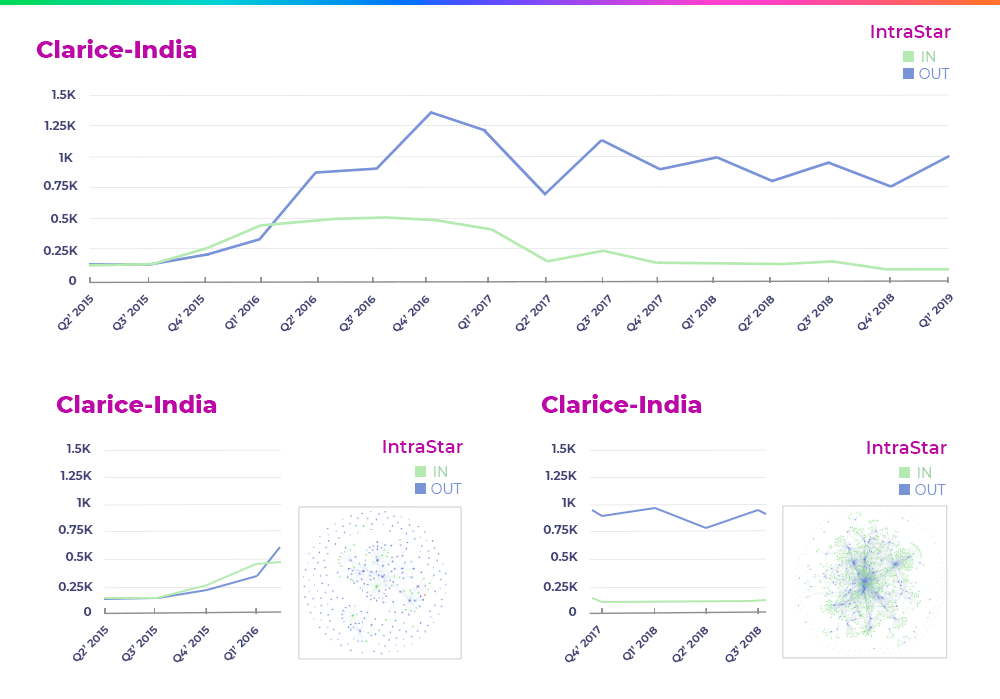
At the first-year mark, we saw a big shift: the number of stars sent by Clarice employees to their colleagues in other Globant offices was almost double the amount sent internally. The data highlighted the tipping point in the cultural integration between the India team and the rest of the organization. This was in large part a result of sending Globant ambassadors from different parts of the organization to India to help with the integration. These individuals were not selected based on their tenure or job title. They were chosen for the strength and depth of their relationships in the organization, which we could see in the data extracted from StarMeUp. This data helped us select individuals who we knew were well connected and well respected in the organization, which we knew would greatly help connect the new employees to their colleagues around the world.
We also did a deeper dive using organizational network analysis (ONA) to make sure that it wasn’t just a select group of individuals that were driving the increased connectivity with the rest of the organization. This is a side-by-side view showing the progression of connections at an individual level. At the beginning of the acquisition, there were just a few individuals from Clarice interacting with Globers in other parts of the world, but three years later there were both a greater number of connections with the rest of the company, as well as exponentially more people connecting with colleagues worldwide.
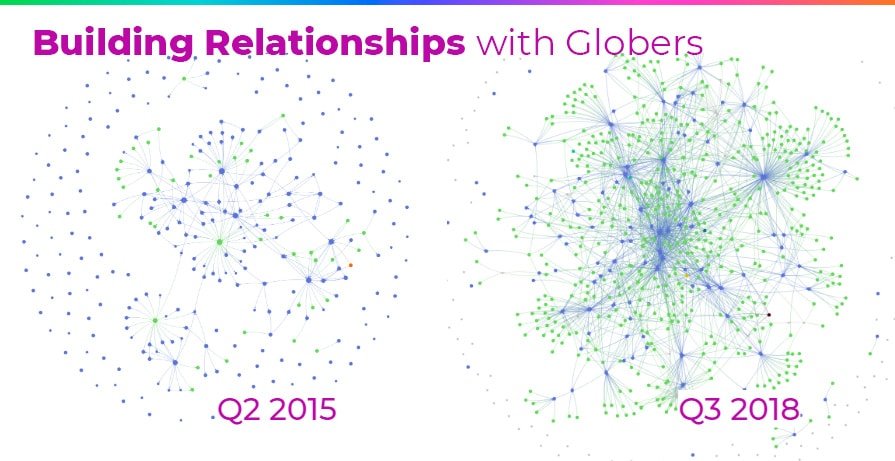
Small Footprint, further expansion into Eastern Europe
As Globant continues to make new acquisitions, it’s important for us to measure the lessons learned from each process and whether we are more effective at acclimating our new employees.
Based on the great success of the ambassador program in India, when we acquired Small Footprint in 2018, we expanded it to create a more personalized mentorship program in an effort to accelerate and deepen the cultural acclimation of our newest team members.
With Clarice, the full cultural acclimation took approximately three years to come to fruition. In comparing Small Footprint with Clarice, we were able to use the lessons learned and accomplish a deep cultural integration in just one year.
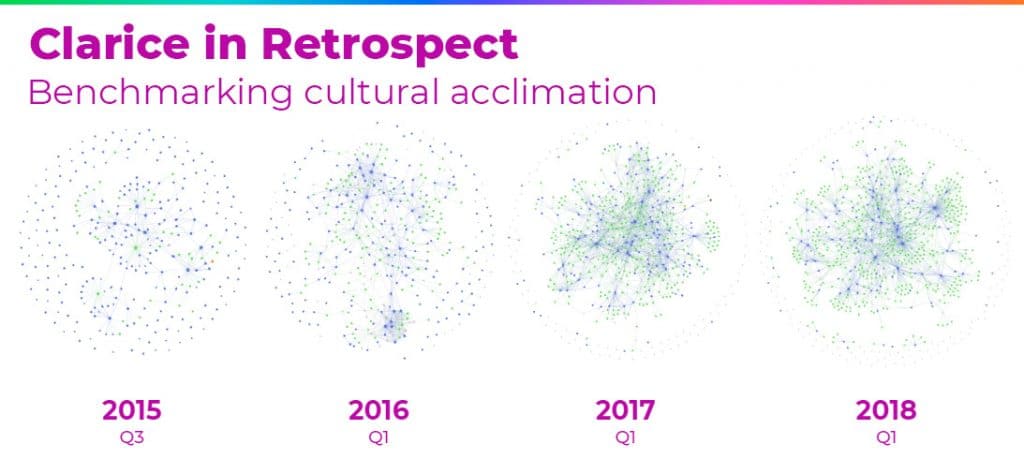
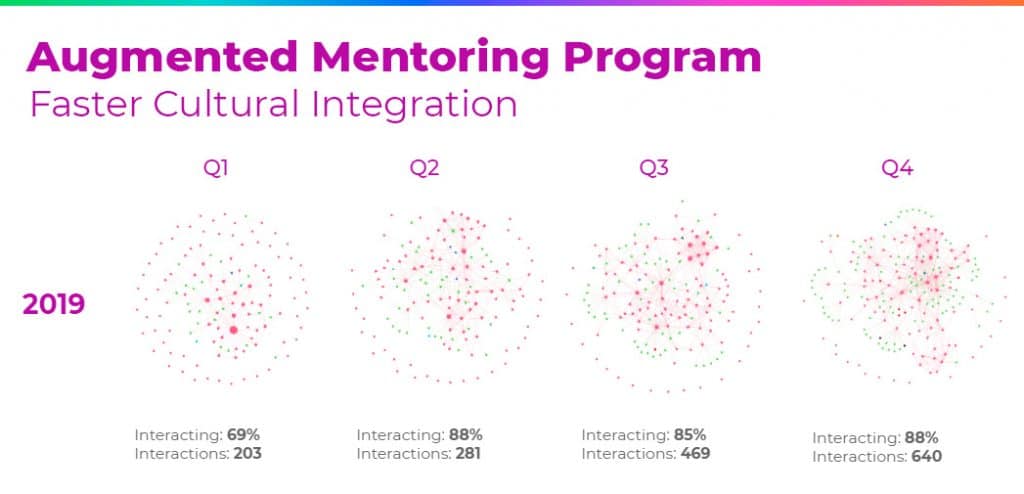
We were able to measure the impact of the mentoring program almost immediately. Our analytics data revealed a great number of employees were building relationships with each other (as measured by interaction percentages) by the second quarter and that these connections were growing stronger over time (as measured by the number of interactions).
An additional highlight of the acquisition is the strong connectivity of women. As a company in a predominantly male industry, making sure we have an inclusive culture is of paramount importance to us. We can see that in Small Footprint employees. Women were actually connecting with others at twice the rate as male colleagues and were connecting with various individuals, not only with each other. This was one of the ways that we were able to make sure that we were creating an inclusive environment for women during the cultural acclimation process.

Belatrix, acquisition of a larger office
In the case of the Belatrix acquisition, the number of employees acquired outnumbered Globant employees in Peru. For organizational cultures that somewhat differed in their formality, in this case, it was of particular importance to find a way to acclimate the new group to the Globant’s particular values and way of working.
We asked one of Globant’s cultural ambassadors who also played a key role in India to spend several months in the Lima offices and help further bring the two groups together.
The ambassador arrived in Peru in December. We almost immediately saw the number of connections grow exponentially through our ONA. We were able to measure the impact of the different activities he initiated and led on getting the employees from the two recently merged companies to quickly function as one.
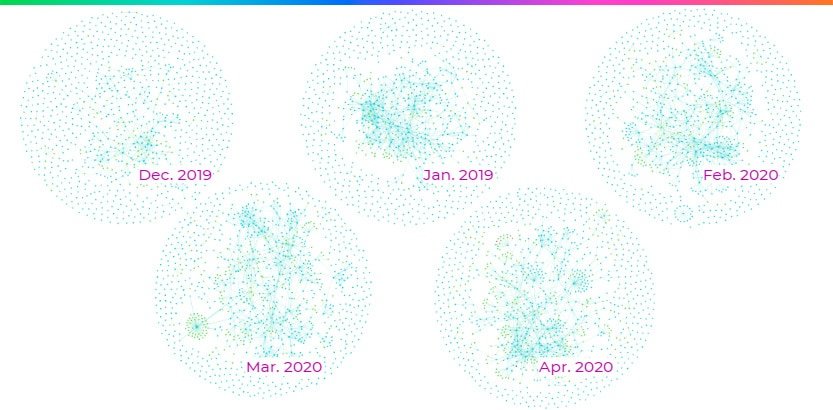
Managing acquisitions through the crisis and beyond
It is critical to keep a pulse on the relationships being formed by employees in as real-time as possible. The data can give organizations affirmation that the strategies they are employing are working or allow them to change course in a timely manner to maximize impact. In Globant’s case, we were still monitoring the acquisition of Small Footprint closely to make sure the merger of our cultures did not deviate when the COVID-19 pandemic broke out. Globant employees worldwide were asked to start working from home and we saw a slight impact on connectivity in March. We acted quickly and the organization’s targeted efforts to keep employees informed, united and supported paid off. We saw a strong rebound in April when the number and strength of connections peaked.
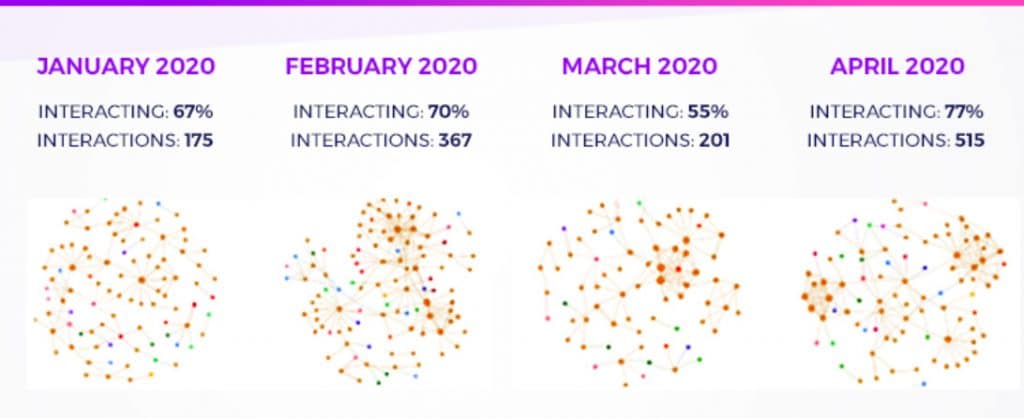
Globally there is a huge investment in M&A, and done correctly they can add incredible value to the business. We hope to see more organizations leverage ONA and people analytics as a way to not only build a more positive employee experience but also improve and speed up the success and impact of M&As.